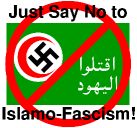PRISONERS OF FREEDOM?
A History of Violence
How did the Palestinians descend into barbarism?
BY BRET STEPHENS (WALL STREET JOURNAL)
Palestinian President Mahmoud Abbas paid George Bush a friendly visit Thursday in the Oval Office. At the Rose Garden press conference that followed, Mr. Bush stressed Mr. Abbas's responsibility to "end terror attacks, dismantle terrorist infrastructure, maintain law and order and one day provide security for their own state." Mr. Abbas himself made no mention of the words "terrorism" or "terrorists." But he did demand the release of those he called "prisoners of freedom," now being held in Israeli jails.
The Israeli-Palestinian conflict no longer rivets world attention the way it did a few years ago. Still it rolls along, as it has for decades and as it probably will for decades to come. And the reason for this is well-captured by Mr. Abbas's use of the term "prisoners of freedom."
Who are some of these prisoners? One is Ibrahim Ighnamat, a Hamas leader arrested last week by Israel in connection to his role in organizing a March 1997 suicide bombing at the Apropos cafe in Tel Aviv, which killed three and wounded 48. Another is Jamal Tirawi of the Al Aqsa Martyrs Brigades: Mr. Tirawi had bullied a 14-year-old boy into becoming a suicide bomber by threatening to denounce him as a "collaborator," which in Palestinian society frequently amounts to a death sentence.
And then there is 21-year-old Wafa Samir al-Bis, who was detained in June after the explosives she was carrying failed to detonate at an Israeli checkpoint on the border with Gaza. As Ms. Bis later testified, her target was an Israeli hospital where she had previously been treated--as a humanitarian gesture--for burns suffered in a kitchen accident. "I wanted to kill 20, 50 Jews," she explained at a press conference after her arraignment.
Consider a statistic: In the first nine months of 2005 more Palestinians were killed by other Palestinians than by Israelis--219 to 218, according to the Palestinian Authority's Ministry of Interior, although the former figure is probably in truth much higher. In the Gaza Strip, the departure of Israeli troops and settlers has brought anarchy, not freedom. Members of Hamas routinely fight gun battles with members of Fatah, Mahmoud Abbas's ruling political party. Just as often, the killing takes place between clans, or hamullas. So-called collaborators are put to the gun by street mobs, their "guilt" sometimes nothing more than being the object of a neighbor's spite. Palestinian social outsiders are also at mortal risk: Honor killings of "loose" women are common, as is the torture and murder of homosexuals.
Atop this culture of violence are the Hamas and Fatah leaders, the hamulla chieftains, the Palestinian Authority's "generals" and "ministers." And standing atop them--theoretically, at least--is the Palestinian president. All were raised in this culture; most have had their uses for violence. For Arafat, those uses were to achieve mastery of his movement, and to harness its energies to his political purpose. Among Palestinians, his popularity owed chiefly to the fact that under his leadership all this violence achieved an astonishing measure of international respectability.
Hence Mr. Abbas's Rose Garden obeisances to the "prisoners of freedom." The Palestinian president leads a society in which dignity and violence have long been entwined, in which the absence of the latter risks the loss of the former. This is not to say that Mr. Abbas himself is a violent man. But his fate as a politician rests in the hands of violent men, and so far he has shown no appetite for confronting them.
Instead, he has sought to entice groups such as Hamas into a democratic process. As with Hezbollah in Lebanon, they have been happy to get what they can out of politics while refusing to lay down their arms. In doing so, they make a mockery of Mr. Abbas's stated commitment to "one authority, one law and one gun"--that is, to the very idea of a state, and therefore to Mr. Abbas's presidency of it.



























No comments:
Post a Comment